Extra details to accompany 'Fibre Mast Vertical Antenna
& pi-Network ATU' November 2020 Practical Wireless article
This link takes you to a PDF of my November 2020 Practical Wireless magazine article - Fibre Mast Vertical Antenna & pi-Network ATU
(I would like to acknowledge Practical Wireless for kind permission to use this PDF of the article)
Radio Enthusiast & Practical Wireless website
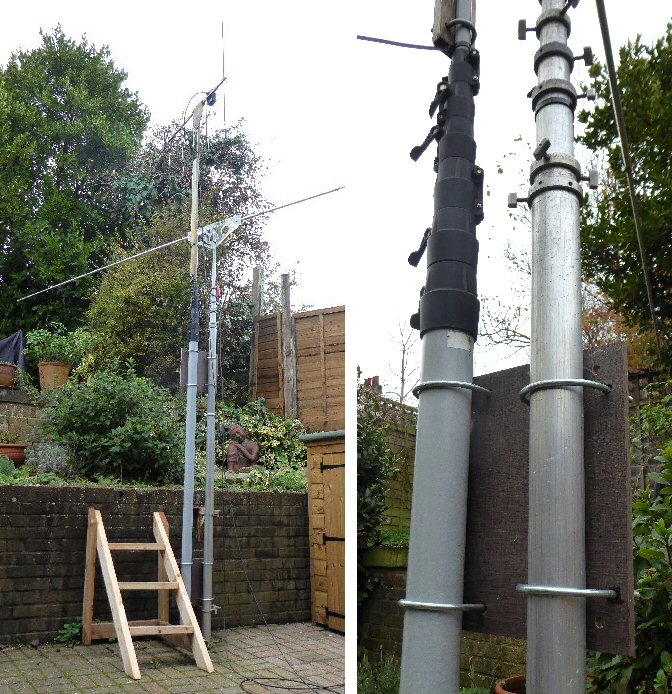
15m fibre mast next to the 12m aluminium (Al) mast.
I used the lowest section of the Al mast to support the fibre mast using two large square Tufnol sheets (ca. 30 x 30 cm x 10 mm).
The Al mast is fixed to the wall using TV K & T type brackets (mounted about 1m apart).
Both masts are retracted of course but when the photo was taken the fibreglass mast had my homemade
144 MHz 5 element ZL special attached to the top while the aluminium mast has a homemade 15m, 12m, and 10m band dipole.
Experimental fibreglass mast supported antennas
My November 2020 Practical Wireless article described an experimental antenna that might form the basis of your own permanent design.
The idea is to have fun playing / experimenting with antennas and I hope it might help you produce something that works for your location / application.
This web page has a few extra details that I could not put in the PW article.
A bit about the masts at my location
I live in the city of Brighton on the South Coast of the UK. I only have a small back yard (ca. 4m x 3m) so vertical antennas are feasible but large horizontal antennas and guy wires are not very easy or practical.
As a result I had to support my masts at the base using TV type wall brackets onto the back yard wall (see photo above).
I have used a 12m aluminium mast (8 sections) for many years with great success but have recently brought a 15m fibreglass mast (7 sections) which has opened up more possibilities. In my current set up I can use both of the masts (but not at the same time of course).
15m better than 12m !
In my location I am close to the top of a chalk hill but have two long rows of terrace houses immediately to the west of me. This causes problems at VHF and UHF to get a decent signal in that direction even with my aluminium mast up at ca.12m or so. 'On air' even an extra few meters of mast makes a big difference and I realised that replacing my current 12m aluminium mast with a 15m mast would be worthwhile. Using a fibre mast would also allow me to experiment with vertical antennas for HF etc.
Buying the fibre mast and how it compares to aluminium mast
Some details of the fibre mast I use are towards the end of this page (e-bay screen grab). It was brought for me as a lovely birthday present so I didn't have to pay for it ! It is a very well made mast with good quality compression fittings between each pole of the mast. It was advertised as being 'stiffer than equivalent aluminium mast' (but the advert didn't supply any further details). My experience is that its roughly comparable in stiffness to my aluminium mast.
Splitting a fibre mast
I know fibreglass masts are very strong but I was still a bit worried that tightening U-bolts around the fibre mast might case it to fracture. I decided to use two large 30 x 30 cm Tufnol sheets about 1.5m apart, to spread the weight load and so I didnt have to tighten the U-bolts greatly.
Why a fibre mast ?
Fibre masts can have some advantages over a metal mast:
i) firstly all the tubes and fasteners are non-metallic so they will not rust or corrode (although time will tell how stable it will be to sunlight / UV etc.).
ii) as its non conducting you can directly support a wire to create a vertical antenna along the length of the mast.
iii) you wont get oxidation between the tubes of the fibre telescopic mast, so the tubes should not stick within each other when you try to put them up
(a problem I have found with metal telescopic masts, especially aluminium masts coping with sea air etc.)
There are some disadvantages to a fibre mast:
1) you have to be a bit more careful how you clamp onto the mast (both for its support and the antenna)
2) you might want to drill the top section of a mast for some reason and although you can drill thick fibre masts I dont recommended it as it could cause a fracture along the rest of the tube.
3) if the mast does get damaged it is probably easier and cheaper to find spare replacement tubes for an aluminium mast than for a fibre mast
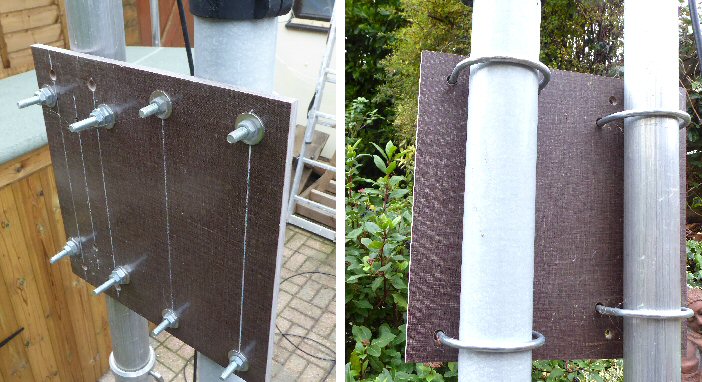
Two views of the top Tufnol square used to securely hold the fibre mast to the lower section of the aluminium mast.
1/2 and 5/8 wave verticals
The fibre mast works very well for quickly putting up 1/2 wave and 5/8 wave verticals. All the main details are discussed in my article (links above and below). One reader asked how I attached the wire to the mast - I simply taped (or use cable-ties) the wire in three or four places along the length of the mast as it goes up.
Experimental helical vertical 80m
The idea here is to wind a long coil around the fibre mast to create a long inductor; like a very long version of the 'rubber duck' antennas used on 2m or 70cm hand held radios.
Note: winding the spiral of the helical antenna is really only possible if the mast is secured at the base (as it is in my use) as there are no guy wires to get in the way as you wind the wire up the mast.
Ideally this vertical needs radials from the base of the antenna but in my location I don't have the space for 1/4 wavelength 80m band radials which would be ca. 20m in length. I used 'random' length radials in the space I happened to have. I use the helical antenna on local 80m nets not as a 'DX' antenna.
For 80m band experiments I simply used ca. 20m of ca. plastic coated wire wrapped around the fibre mast. The wire was a standard muti-core wire having an outside plastic about 2mm diameter. I used a cable tie to secure the end of the wire to the top pole. It is then fairly easy to create a spiral along the length of the mast if you turn the mast as you luff up each section. I found I could put up the helical antenna in just a few minutes, however it was awkward to take it down without creating a birds nest of wire. Using 5 mm plastic coated cable proved to be much easier to handle as it tended to unwind creating large loops as you bring the mast down.
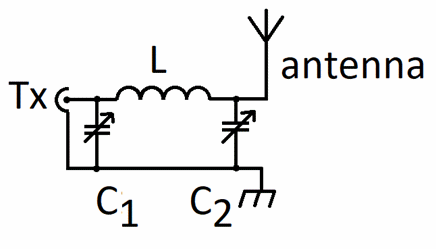
π-network matching unit
A bit about the ATU
I made up a simple π-network to match the anetenna to the transmission line. In most cases it worked well but in some instances I found I did not need much capacitance for C1 or perhaps C2 (above and see article) i.e. I found I had to move the capacitor till the vanes were completely un-meshed (in which case you could remove the un-messed one all together). But, if like me, you want to constantly change the set-up to try out all sorts of different antenna arrangements then keep the two capacitors wired permanantly in circuit but adjust them accordingly.
Future Experiments - Top-band 160m helical vertical
I have tried using the 80m helical (20m of wire along the length of the mast) on Top Band (160 m) and my ATU did cope with it well on relatively low power (ca. 10 - 20 watts) but it struggled for higher powers. My plan now is to add more reactance into the system by adding a light weight capacitance hat to the top of the mast made from four (or perhaps eight) 1m long aluminium rods fitted as a star to the top of the mast. The center of the star will be a small sheet of aluminium to connect them all together and this will be connected to the top end of the helical coil wire.
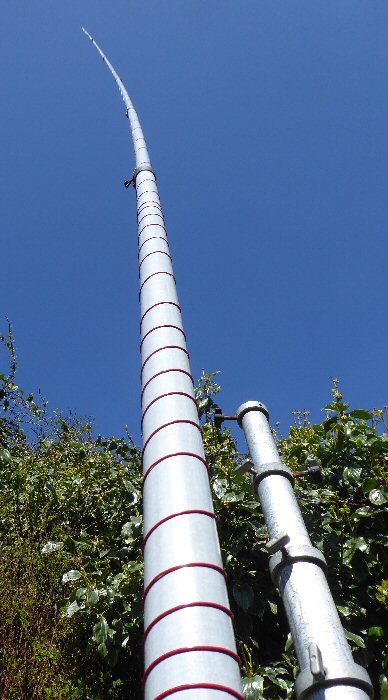
Looking up the experimental 80m band helical antenna (perhaps 160m, see text):
20m of plastic coated wire wrapped around the fibre mast by turning the mast as it is put up.
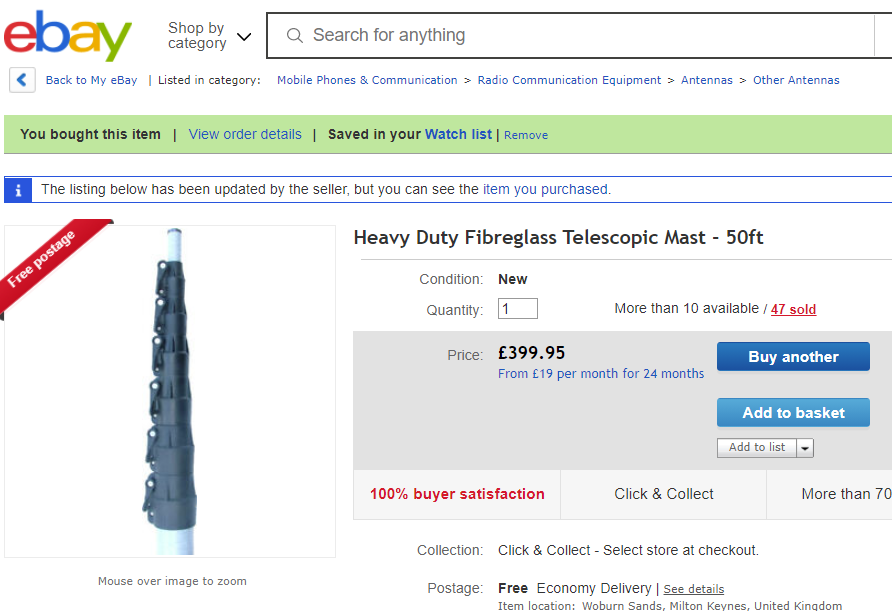
e-bay advert for my 15m (50 foot) fibre mast.
THE CREATIVE SCIENCE CENTRE
Dr Jonathan Hare University of Sussex, Brighton.
e-mail: j.p.hare@sussex.ac.uk
home | diary | whats on | CSC summary | latest news




